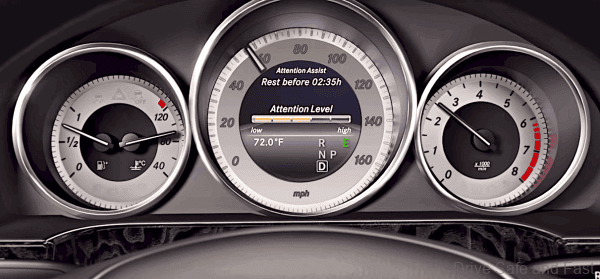Have You Heard Of Mercedes-Benz ATTENTION ASSIST System
How does ATTENTION ASSIST Work?
For many Mercedes-Benz owners, this feature has not been explained to them by the salesperson and the reason is simple. Mercedes-Benz provides a lot of features, even in their simple models and it will take hours to explain every single feature. So the salespeople will explain the most important features and then there is the owners manual, sometimes websites like www.dsf.my and the internet to assist with all other features.
This was an industry-first by Mercedes-Benz. ATTENTION ASSIST uses a sensor and detailed algorithm to detect fatigued driving behavior. Here below is how it works.
- ATTENTION ASSIST analyzes driving behavior in the first few minutes of your ride and assesses your personal driving techniques using over 70 parameters.
- While you are driving, ATTENTION ASSIST will identify certain steering corrections that indicate drowsiness and fatigue. ATTENTION ASSIST will also consider external factors, including road conditions, crosswinds, and your interaction with vehicle controls.
- After considering these external factors, ATTENTION ASSIST will send you an alert that suggests you take a break from driving if it determines that your driving behavior is due to fatigue.

So, the next question is, which Mercedes-Benz Vehicles Offer ATTENTION ASSIST?
Well, at the moment ATTENTION ASSIST is offered on most new Mercedes-Benz models.
- C-Class
- E-Class
- S-Class
- CLA
- CLS
- GLA
- GLC
- GLE
- GLS
- G-Class
- SLC
- SL-Class
- Mercedes-AMG GT

Press Release: Mercedes-Benz accident researchers warn against falling asleep momentarily whilst driving. Drivers who do not take regular breaks when driving long distances run a high risk of becoming drowsy – a state which they often fail to recognize early enough according to the experts. This is why Mercedes-Benz has developed the innovative ATTENTION ASSIST system, which can detect when drivers start to become drowsy and prompt them to take a break before it’s too late. The system will be fitted as standard in the new E‑Class and the model year 2009 S-Class.
Scientific studies conclude that around 25 percent of all serious highway accidents are down to driver drowsiness, meaning that drowsiness causes more road accidents than drink-driving.
The risk of falling asleep momentarily is at its greatest on long-distance journeys in the dark or in unchanging conditions because this is when drivers are most likely to suffer a lapse in attention. The sheer monotony further heightens the risk of falling asleep at the wheel.
Studies show that, after just four hours of non-stop driving, drivers’ reaction times can be up to 50 percent slower. So the risk of an accident doubles during this time. And the risk increases more than eight-fold after just six hours of non-stop driving!
The newly developed ATTENTION ASSIST system sees Mercedes-Benz continuing to adopt a practically-oriented stance towards accident avoidance. A stance which has already lead to a proven improvement in road safety thanks to developments such as the Electronic Stability Program (ESP®) and Brake Assist.
ATTENTION ASSIST observes the driver’s behaviour and, at the start of every trip, produces an individual driver profile that is then continuously compared with current sensor data.
This permanent form of monitoring is important for detecting the floating transition from awakeness to drowsiness and for warning the driver in plenty of time. The system is active at speeds of between 80 and 180 km/h.
Steering behaviour as the key indicator of drowsiness
As well as the speed, lateral acceleration and longitudinal acceleration, the Mercedes system also detects steering wheel movements, use of the turn indicators or pedals and certain control inputs, not to mention external influences such as side winds or road unevenness, for example.
Observation of steering behaviour has proven to be extremely meaningful as drowsy drivers find it difficult to steer a precise course in their lane. They make minor steering errors that are often corrected quickly and abruptly. Intensive tests carried out by the Mercedes engineers, involving more than 550 drivers, show that this effect occurs at a very early stage when drowsiness kicks in – often before the dangerous situation in which the driver falls asleep momentarily.
ATTENTION ASSIST: how the Mercedes system detects drowsiness
At the heart of this Mercedes system is a highly sensitive sensor which allows extremely precise monitoring of the steering wheel movements and the steering speed.
Based on these data, ATTENTION ASSIST calculates an individual behavioural pattern during the first few minutes of every trip. This pattern is then continuously compared with the current steering behaviour and the current driving situation, courtesy of the vehicle’s electronic control unit. This process allows the system to detect typical indicators of drowsiness and warn the driver by emitting an audible signal and flashing up an unequivocal instruction on the display in the instrument cluster: “ATTENTION ASSIST. Break!”